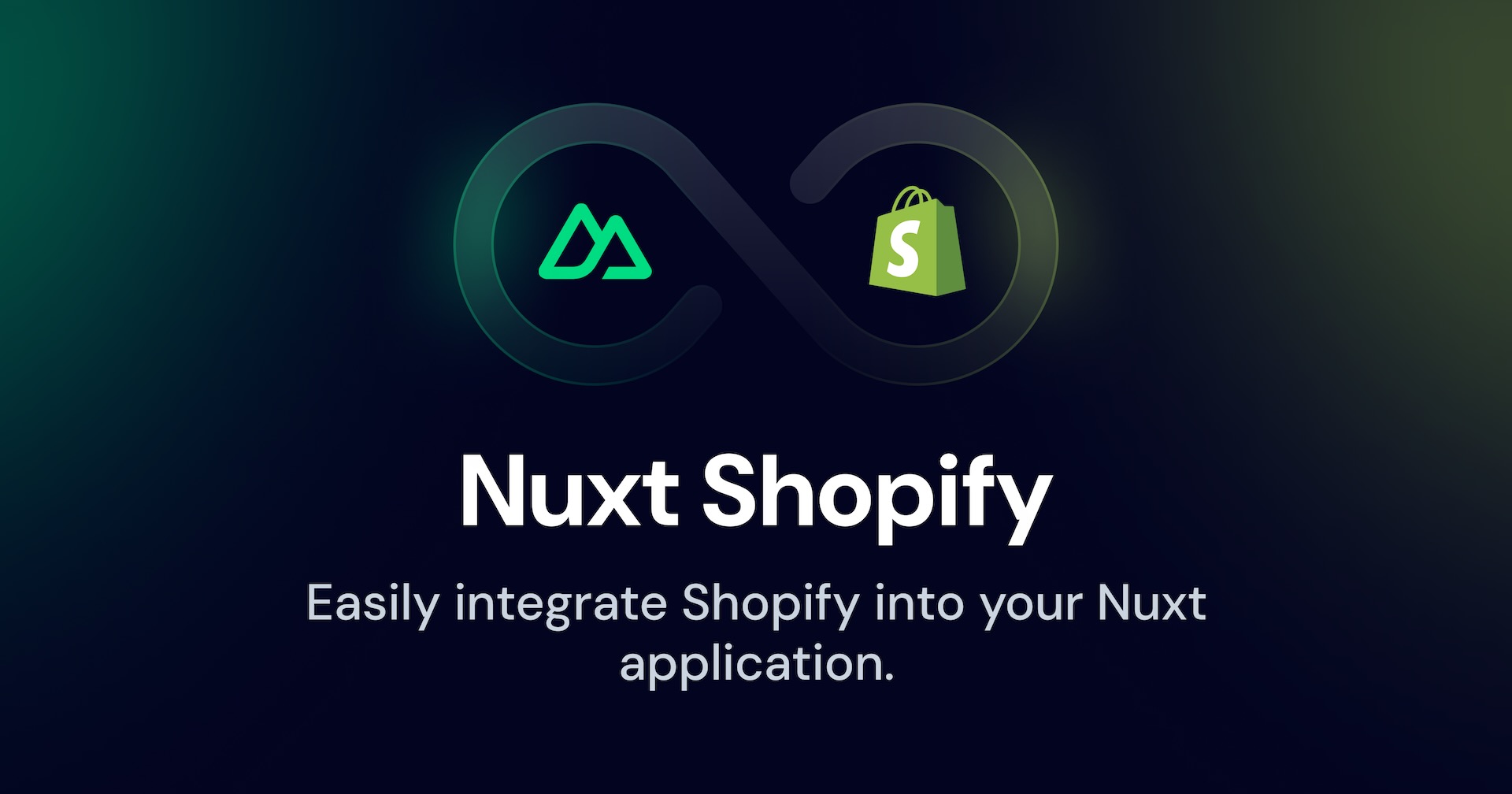
Nuxt Shopify 模組
適用於 Shopify 店面 API 和 Shopify 管理 API 的全型別化 fetch 客戶端。您可以在伺服器端和客戶端使用它,內建支援 mock.shop,並能根據您的 GraphQL 查詢自動熱過載型別生成。
- 🛍️ 商店模板(即將推出)
- 📚 文件
- ✨ 釋出說明
⚡️ 功能
- 🔗 從 GraphQL 模式生成完全型別化的 fetch 客戶端
- 🔥 當您的 GraphQL 發生變化時自動熱過載型別
- 🔐 安全訪問令牌處理
- 🛒 支援店面和管理 API
- 🌐 支援伺服器和客戶端
- 🛠️ 自動整合 mock.shop
- 🚩 針對 Nuxt 最佳化的錯誤處理
- 📡 用於 API 請求的伺服器端代理
- 🧩 支援 GraphQL 片段
- ⚙️ 可定製的 GraphQL 程式碼生成
- 📦 GraphQL 查詢和生成型別的自動匯入
- 🏖️ 與 GraphiQL Explorer 整合的沙盒
- 🔄 用於自定義模組行為的鉤子
- 🧪 經 Nuxt 3 和 4 測試
路線圖
1.0.0 版本即將推出的功能和開發
- 🏎️ 支援子請求快取
- 👤 支援客戶賬戶 API
- 🔍 支援 Shopify Analytics
- 🪝 支援 Webhook 訂閱
- 🛍️ 帶有 Nuxt UI 和 Nuxt Content 的商店模板
📦 設定
執行以下命令在您的專案中安裝模組
npx nuxt@latest module add nuxt-shopify
或者使用手動安裝
- 透過 npm 安裝模組
npm install @nuxtjs/shopify - 將模組新增到您的
nuxt.config.tsexport default defineNuxtConfig({ modules: [ '@nuxtjs/shopify', ], })
將您的 Shopify 配置新增到 nuxt.config.ts
export default defineNuxtConfig({
shopify: {
name: 'quickstart-abcd1234',
clients: {
storefront: {
apiVersion: '2025-07',
publicAccessToken: 'YOUR_ACCESS_TOKEN',
},
admin: {
apiVersion: '2025-07',
accessToken: 'YOUR_ACCESS_TOKEN',
},
},
},
})
🛠️ 用法
在客戶端訪問店面 API
有多種方式與 Shopify API 通訊。最簡單的方式是直接在您的 Vue 元件或頁面中使用 useStorefront 可組合函式。
要在客戶端訪問
useStorefront可組合函式,請確保您已新增公共訪問令牌。您可以在模組配置中新增它:clients > storefront > publicAccessToken
<!-- ~/pages/your-page.vue -->
<script setup lang="ts">
const storefront = useStorefront()
const { data } = await storefront.request(`#graphql
query FetchProducts($first: Int) {
products(first: $first) {
nodes {
id
title
description
}
}
}
`, {
variables: {
first: 3,
},
})
</script>
<template>
<pre>{{ data?.products }}</pre>
</template>
這將從您的 Shopify 商店獲取前三個產品,並在 <pre> 標籤中顯示它們。
data 變數將被型別化為 FetchProductsQuery,這是由模組自動生成的,以實現自動補全和全面的型別檢查。
您可以在程式碼中的任何地方使用這個生成的 FetchProductsQuery 型別,以確保在元件中處理查詢響應時的型別安全。
結合 useAsyncData 使用店面 API
您還可以使用 useStorefrontData 可組合函式從店面 API 獲取資料,同時利用 Nuxt 內建的非同步資料獲取功能。
<!-- ~/pages/your-page.vue -->
<script setup lang="ts">
const { data: products, error } = await useStorefrontData('products', `#graphql
query FetchProducts($first: Int) {
products(first: $first) {
nodes {
id
title
description
}
}
}
`, {
variables: {
first: 3,
},
// Use features from useAsyncData, e.g. transform, pick, etc.
transform: (data) => flattenConnection(data.products),
})
</script>
<template>
<pre>{{ products }}</pre>
</template>
請注意,useStorefrontData 會自動從響應中提取 data 屬性,以便能夠可靠地進行字串化。當與設定 errors: { throw: false } 一起使用時,您需要在響應中手動檢查錯誤,而不是使用 useStorefrontData 可組合函式返回的 error 物件。
透過 Nitro 端點訪問 API
該模組公開了透過 Nitro 端點訪問每個 API 的實用工具。
店面 API 示例
您可以使用 useStorefront 實用工具來訪問店面 API
// ~/server/api/products.ts
export default defineEventHandler(async () => {
const storefront = useStorefront()
return await storefront.request(`#graphql
query FetchProducts($first: Int) {
products(first: $first) {
nodes {
id
title
description
}
}
}
`, {
variables: {
first: 3,
},
})
})
請注意,我們如何在事件處理程式內部使用 graphql 指令,這是因為在標準模組配置中,所有 .ts 和 .gql 檔案都會自動為店面 API 進行處理,只要它們不以 .admin.ts 或 .admin.gql 結尾。閱讀更多關於 程式碼生成配置 的資訊。
現在我們可以呼叫 /api/products API 來獲取前三個產品
<!-- ~/pages/your-page.vue -->
<script setup lang="ts">
const { data } = await useFetch('/api/products')
</script>
<template>
<pre>{{ data }}</pre>
</template>
data 變數將被型別化為 Ref<ClientResponse<FetchProductsQuery>>,這使得自動補全和全面的型別檢查成為可能。
管理員 API 示例
以 .admin.ts 或 .admin.gql 結尾的檔案將自動為管理 API 處理。我們可以在 Nitro 事件處理程式中使用 useAdmin 實用工具來訪問管理 API
// ~/server/api/your-admin-api-handler.ts
export default defineEventHandler(async () => {
const admin = useAdmin()
return await admin.request(...)
})
有關完整示例,請參閱 管理員 API 示例。
模擬店面 API
要模擬店面 API,您可以在模組配置中使用 mock 選項
export default defineNuxtConfig({
shopify: {
name: 'my-mocked-shopify-store',
clients: {
storefront: {
mock: true,
apiVersion: '2025-07',
},
},
},
})
現在,所有對店面 API 的請求都將從 mock.shop 返回資料,而不是實際呼叫 Shopify API。
代理客戶端請求
預設情況下,所有從客戶端發出的請求都會透過 Nitro 伺服器進行代理。要停用代理,您可以在模組配置中設定 proxy 選項。代理僅在 SSR 模式下可用。
export default defineNuxtConfig({
shopify: {
clients: {
storefront: {
proxy: true,
},
},
},
})
型別生成
安裝後,模組會自動生成您的 GraphQL 型別並將其儲存在
- .nuxt/types — 型別定義
- .nuxt/schema — GraphQL 模式檔案
要啟用 IDE 支援,您可以新增一個 GraphQL 配置檔案
# ~/graphql.config.yml
schema:
- ./.nuxt/schema/storefront.schema.json
- ./.nuxt/schema/admin.schema.json
處理 GraphQL 片段
您可以在 GraphQL 查詢中定義可重用片段,以避免重複並使查詢更易於維護。該模組開箱即用支援片段。
這是一個如何定義和使用片段的示例
#graphql
fragment ProductFields on Product {
id
title
description
}
query FetchProducts($first: Int) {
products(first: $first) {
nodes {
...ProductFields
}
}
}
您可以將此查詢放置在 .gql、.ts 或 .vue 檔案中,並在您的請求中使用它。模組將能夠匯入片段並允許您直接在 GraphQL 操作中使用它。
放置在 ~/graphql 目錄中的檔案將由模組自動匯入,因此建議在那裡組織您的片段。
錯誤處理
預設情況下,如果店面或管理員客戶端遇到錯誤,模組將丟擲錯誤,而不是在響應中返回錯誤物件。這樣做是為了讓 Nuxt 能夠接管錯誤處理。
您可以透過在模組配置中設定 errors.throw 選項來定製此行為。
export default defineNuxtConfig({
shopify: {
errors: {
throw: false,
},
},
})
這將阻止模組丟擲錯誤,而是返回錯誤響應。
該模組還提供用於處理錯誤的鉤子。
// ~/server/plugins/your-plugin.ts
export default defineNitroPlugin((nitroApp) => {
nitroApp.hooks.hook('storefront:client:errors', ({ errors }) => {
// Do something with the errors
console.log('Storefront client errors:', errors)
})
})
在我們的鉤子文件中閱讀更多關於所有可用鉤子的資訊。
👥 維護者
🤝 貢獻
- 克隆此倉庫
- 建立一個
.env檔案(參見.env.example) - 使用以下命令安裝依賴項
bun install - 執行
bun run prepare:dev生成型別存根。 - 使用以下命令啟動預設的 playground
bun run dev
📜 許可證
根據 MIT 許可證釋出。




